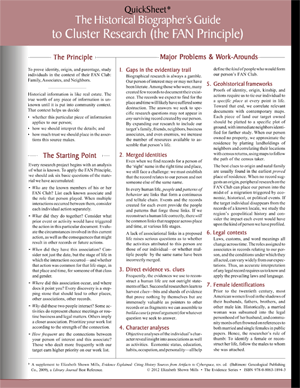15 February 2015
 "Here's my challenge," a history researcher wrote recently on social media. "How do I write a biography of someone from the 1700s with little direct documentation available?"
"Here's my challenge," a history researcher wrote recently on social media. "How do I write a biography of someone from the 1700s with little direct documentation available?"
Oh, yeah! We all know that problem. It is a challenge, but it's doable. Successful historical biographers—after they conclude that they have already exhausted available records for their person-of-interest—usually take this approach:
- Study every history of every type that has been written on the region—social, religious, military, economic, or whatever. If newspapers are available and have yielded no hits for their person, they read those papers anyway, every issue for the relevant time frame.
- Rather than looking for a particular person, they use these sources to draw an understanding of the region. That understanding of what life was like, at the time and place, enables them to recreate their person's environment and to place their person—accurately and meaningfully—upon that stage of history. Whatever few personal details they had gleaned from their focused study should enable them to determine the strata of society to which their person belonged and the kind of role their person would have played. That is something they can write about, and putting a person into historical context is an essential part of biography.
- Presumably their focused research on that person included his or her "FAN Club,"1 in which case some of the elusive person's friends, associates, or neighbors will appear in those newspapers or general histories. Their activities offer a framework for better understanding why that person-of-interest did or did not participate in the same events as their associates. So, these biographers ask: Have I taken my research on these associates beyond the basic records? Have I combed online catalogs of manuscript sources to determine whether the neighbors, pastors, or other "unofficial record keepers" of the region left diaries or letters that might provide more evidence for the elusive person's life?
- Successful biographers, when they digest those general histories, also study them for their sources. Most modern works will have reference notes or bibliographies (a general list of sources used). Many olders ones don't (and many modern ones are incomplete). Therefore, historical biographers watch for instances in which sources are generically mentioned in the text and compile their own worklist of new sources to pursue. Doing so almost always generates new information on the low-key, limelight-shunning person-of-interest—or, at the least, a better understanding of what he or she would have done and why.
E's QuickSheet series, The Historical Biographer's Guide to ..., offers many other ideas.
1. For more on this principle, see Elizabeth Shown Mills, "QuickLesson 11: Identity Problems & the FAN Principle," Evidence Explained (https://www.evidenceexplained.com/content/quicklesson-11-identity-problems-fan-principle : posted 26 August 2012).